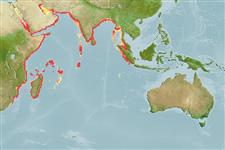Common names from other countries
Environment: milieu / climate zone / depth range / distribution range
Ecologia
; estuarina; intervalo de profundidade 1 - 170 m (Ref. 8), usually 10 - 30 m (Ref. 8). Tropical, preferred 26°C (Ref. 107945); 30°N - 31°S, 29°E - 103°E
Indo-West Pacific and Southern Atlantic. Introduced in the Mediterranean. Tropical to subtropical.
Length at first maturity / Tamanho / Peso / Idade
Maturity: Lm 12.7, range 11 - 12 cm Max length : 19.9 cm TL macho/indeterminado; (Ref. 119750); 22.6 cm TL (female); Idade máx. registada: 2.50 anos (Ref. 104940)
Maximum carapace length: 5.0 cm (female; Ref. 8). Prefers bottom sandy mud (Ref. 8). Also occurs on seagrasses, mudflats, sandflats and mangrove channels. Frequently burrows (Ref. 106912). Feeds on crustaceans, polychaetes, mollusks, fishes, algae and detritus (Ref. 104916).
Mating behavior: Precopulatory courtship ritual is common (through olfactory and tactile cues); usually indirect sperm transfer (Ref. 833). Females spawn once every two (2) months (Ref. 104933).
Holthuis, L.B. 1980. (Ref. 8)
Status na Lista Vermelha da IUCN (Ref. 130435)
Status no CITES (Ref. 108899)
Not Evaluated
Not Evaluated
Uso pelos humanos
Pescarias: espécies comerciais; isca: occasionally
FAO - pescarias: landings | FishSource | Sea Around Us
Ferramentas
Fontes da internet
Estimates based on models
Preferred temperature
(Ref.
115969): 25.2 - 29.3, mean 27.8 (based on 258 cells).
Resiliência
Elevada, tempo mínimo de duplicação da população menor que 15 meses (K=0.67-2.2; tmax=2.5).
Prior r = 1.11, 95% CL = 0.74 - 1.67, Based on 2 data-limited stock assessments.
Vulnerabilidade
Low vulnerability (10 of 100).
